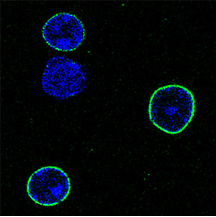Discovery of Extremely Long-Lived Proteins May Provide Insight into Cell Aging and Neurodegenerative Diseases
One of the big mysteries in biology is why cells age. Now scientists at The Scripps Research Institute and the Salk Institute for Biological Studies report they have discovered a weakness in a component of brain cells that may explain how the aging process occurs in the brain.
The scientists discovered that certain proteins, called extremely long-lived proteins (ELLPs), which are found on the surface of the nucleus of neurons, have a remarkably long lifespan.
While the lifespan of most proteins totals two days or less, the researchers identified ELLPs in the rat brain that were as old as the organism, the team reported recently in Science Express, an advance, online publication of the journal Science.
“For the first time we report an intracellular protein machine with protein components in excess of a year in age in the core of the nuclear pore complex,” said Jeffrey Savas, a research associate in the Scripps Research laboratory of Professor John Yates III and co-first author of the study with Brandon Toyama of Salk Professor Martin Hetzer’s group. “This finding may have important consequences in the aging process since the selectivity of the pores declines with age. Deterioration of these proteins may enable toxins to enter the nucleus, leading to cellular aging.”
ELLPs make up the transport channels on the surface of the nucleus; gates that control what materials enter and exit. Their long lifespan might be an advantage if not for the wear-and-tear that these proteins experience over time. Unlike other proteins in the body, ELLPs are not replaced when they incur aberrant chemical modifications and other damage.
Damage to the ELLPs weakens the ability of the three-dimensional transport channels that are composed of these proteins to safeguard the cell's nucleus from toxins. These toxins may alter the cell's DNA and thereby the activity of genes, resulting in cellular aging.
Savas notes that two of the discovery-enabling technologies for this study—MudPIT and N15 labeling of mammals—were developed in the Yates laboratory. MudPIT (multidimensional protein identification technology)—a two-dimensional chromatographic separation, coupled with electrospray mass spectrometry—facilitates proteome-wide analysis. Using N15 metabolic labeling, the scientists were able to track protein turnover through restricting animals’ diet to exclusively N15 spirulina.
In addition to Savas, Toyama, Yates, and Hetzer, authors of the study, “Extremely Long-Lived Nuclear Pore Proteins in the Rat Brain,” include Tao Xu of Scripps Research. For more information on the study, see http://www.sciencemag.org/content/early/2012/02/01/science.1217421.abstract.
Support for this study was provided by the National Institutes of Health, the Hewitt Foundation, Ellison Medical Foundation, and Glenn Foundation.
Send comments to: press@scripps.edu














